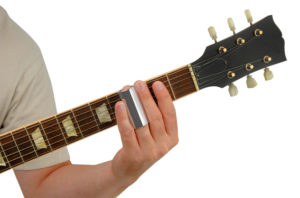by Metro Music Makers instructor Mark Grundhoefer
I started playing guitar in the early 90s. Instead of YouTube or Spotify, the only way I could discover new music was to go through my dad’s record collection. My top five albums of all time were in that collection. One in particular would catch my eye and change the way I played guitar forever: At Fillmore East by the Allman Brothers Band.
Not only was this record huge in shaping the way I approach improvisation and composition, but it introduced me to Duane Allman and his remarkable approach to slide guitar. At the time, I had no idea how he was creating the incredibly vocal-like guitar lines. It was a sound I had never heard, and I couldn’t wait to get to my guitar lesson and find out how he did it.
 The first thing I discovered was that it wasn’t his fingers producing the sound. It was a slide. Slides can be made of many different materials. The most common are glass and metal. In the 1960s, players used glass medicine bottles. Today, some players use ceramic, brass, and even stone slides. You can find them in the accessory section of any music store or go online and discover some of the smaller boutique builders who not only make functional slides out of unusual materials, but aesthetically interesting products. I have a dozen slides at home that are made of all different materials. Each one creates a different sound from the next, and I have found that I can achieve the sounds I want by pairing certain materials with different guitars.
The first thing I discovered was that it wasn’t his fingers producing the sound. It was a slide. Slides can be made of many different materials. The most common are glass and metal. In the 1960s, players used glass medicine bottles. Today, some players use ceramic, brass, and even stone slides. You can find them in the accessory section of any music store or go online and discover some of the smaller boutique builders who not only make functional slides out of unusual materials, but aesthetically interesting products. I have a dozen slides at home that are made of all different materials. Each one creates a different sound from the next, and I have found that I can achieve the sounds I want by pairing certain materials with different guitars.
If you’re unfamiliar with slide guitar technique, let’s break it down. The sound is created by moving the slide across the strings instead of fretting. The slide is a tube-shaped cylinder that is placed over a finger on the fretting hand. Every player is different, but the most common finger used for slide is the ring finger (3rd finger). Once set up it, is moved side to side while applying just a little pressure. The most common mistake is to push the slide down as you would with your finger. Instead, just touch the string with enough pressure to make constant. When played correctly, it creates a glissando effect, similar to a voice.
Most slide players do not play in standard tuning. The use of open chord tuning allows for the straight bar or the slide to be used to play chords. Take your guitar in standard tuning and strum all the strings open. It doesn’t sound great. If you fret all the strings at the 5th fret, it doesn’t sound any better. Now try tuning to open G (DGDGBD) or open D (DADF#AD) and do the same thing. Now you’re playing chords! This helps slide players find more options, since they can only play in a straight line up and down (because that’s how a slide is shaped). However, standard tuning slide playing is becoming more popular, and is the only way I play slide.
Check out these great slide players (plus one of me):
Duane Allman (slide solo at 3:55) https://youtu.be/Fyhyor0yU3o
Derek Trucks (slide solo at 4:15) https://youtu.be/xbOlgESKbIc
Ry Cooder https://youtu.be/x4KmbUCwkyE
Joey Landreth https://youtu.be/KAAAoRxvFq0
Sonny Landreth https://youtu.be/Pf2k7WpkIxQ
Allen Hinds https://youtu.be/0MlMpYCYLiw
Mark Grundhoefer https://instagram.com/p/BgRJ_ZWAboA/
